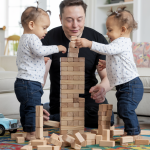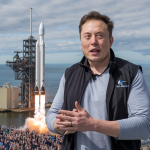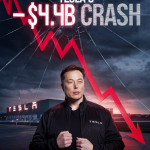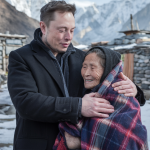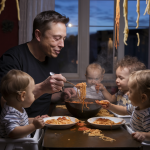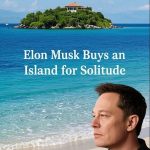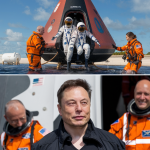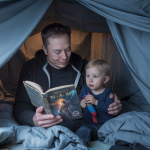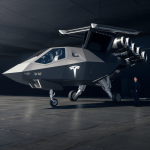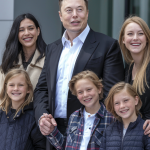Elon Musk’s Bold Vision: Tesla’s Robotaxi to Redefine Urban Mobility

Elon Musk, the enigmatic trailblazer behind Tesla, SpaceX, and Neuralink, has once again ignited global curiosity with a tantalizing hint: a Tesla Robotaxi service is on the horizon, poised to transform how we navigate cities. With a single post on X, Musk teased a driverless taxi network that could make traffic jams, parking woes, and even car ownership relics of the past. As urban populations swell and congestion chokes our streets, Tesla’s Robotaxi promises a future where AI-driven cars whisk us to our destinations—safely, efficiently, and affordably. Buckle up as we explore Musk’s latest brainchild, its potential to revolutionize urban transport, and what it means for the world.
The Teaser That Sparked a Frenzy

On a crisp April morning in 2025, Musk took to X with a cryptic message: “Tesla’s next move will make cities move smarter. Driverless, seamless, electric. Stay tuned.” No press conference, no flashy demo—just a spark that sent Tesla fans, investors, and urban planners into overdrive. The hashtag #Robotaxi trended within hours, with speculation swirling about a driverless taxi service powered by Tesla’s Full Self-Driving (FSD) tech. Was this the Cybercab unveiled in 2024? A new fleet of Model 3s and Ys turned taxis? Or something entirely unexpected?
Musk’s teasers are nothing new. For years, he’s promised autonomous vehicles that could redefine Tesla’s value—potentially adding trillions to its market cap. In October 2024, he showcased the Cybercab, a sleek, steering-wheel-free prototype, at the “We, Robot” event in Burbank, California. He followed up in January 2025, confirming a paid Robotaxi service would launch in Austin by June, with Model 3s and Ys offering unsupervised FSD rides. This latest hint feels like a crescendo, suggesting Tesla is closer than ever to delivering on its decade-long dream.
What Is the Tesla Robotaxi?
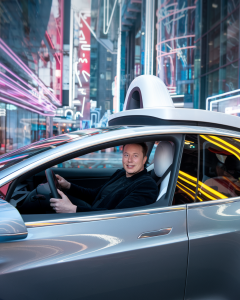
Imagine hailing a ride via an app, stepping into a Tesla with no driver, and gliding to your destination while you read, work, or nap. That’s the Robotaxi vision. Unlike traditional ride-hailing services like Uber, Tesla’s service would rely entirely on AI, eliminating human drivers and their associated costs. The Cybercab, a two-seater with butterfly doors and inductive charging, is the flagship—a purpose-built taxi costing under $30,000, slated for production in 2026. Meanwhile, existing Tesla models equipped with unsupervised FSD could join the fleet, letting owners earn passive income by renting out their cars.
The tech behind it? Tesla’s FSD software, now in its “unsupervised” phase, uses cameras and neural networks to navigate complex urban environments. Unlike competitors like Waymo, which rely on expensive Lidar sensors, Tesla bets on vision-based AI—a cheaper, scalable approach. Musk claims this could make Robotaxis 10-20 times safer than human-driven cars, with operating costs as low as 20 cents per mile, compared to $1 for city buses. If successful, it’s not just a taxi service—it’s a reinvention of urban life.
Why Cities Need Robotaxis
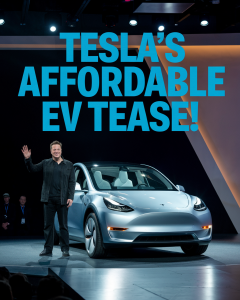
Urban mobility is in crisis. By 2050, the UN projects 68% of the world’s population will live in cities, straining roads, parking, and public transit. In the U.S., commuters lose 54 hours a year to traffic, per INRIX, costing billions in productivity. Air pollution from gas-powered cars fuels climate change, while parking lots gobble up space that could be parks or homes. Enter the Robotaxi: a zero-emission, space-saving solution that could slash congestion and reclaim cities for people.
Picture downtowns free of parked cars, with Robotaxis circling efficiently or charging at compact hubs. Musk envisions a world where “parking lots become parks,” as shared autonomous fleets reduce the need for private vehicles. A 2023 MIT study estimated that autonomous taxis could cut urban traffic by 30% by optimizing routes and pooling rides. For commuters, it’s time saved; for cities, it’s cleaner air and more livable spaces. Musk’s tease taps into this urgency, positioning Tesla as the answer to a global problem.
The Road So Far: Musk’s Autonomous Journey

Musk’s Robotaxi dream dates back to 2016, when he outlined a “Tesla Network” of self-driving cars. In 2019, he boldly predicted a million Robotaxis by 2020—a timeline that didn’t pan out. Regulatory hurdles, tech challenges, and safety concerns slowed progress. Tesla’s Autopilot and FSD systems faced scrutiny, with the NHTSA probing crashes linked to driver-assist features. Yet, Tesla has made strides: FSD’s latest iterations handle city streets, stoplights, and pedestrians with growing reliability.
The 2024 Cybercab reveal was a milestone, showcasing a vehicle designed from scratch for autonomy. At the Burbank event, attendees rode in Cybercabs on a controlled lot, marveling at their responsiveness. Musk followed up with a January 2025 earnings call, announcing Austin’s June launch and unsupervised FSD for Model 3s and Ys in California and Texas by year-end. Posts on X buzz with excitement, with users like @DimaZeniuk noting expansion plans across U.S. cities. This April tease feels like Musk signaling the finish line is near.
How Robotaxis Could Change Everything
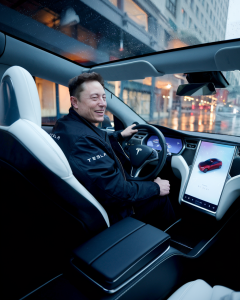
The implications of a Tesla Robotaxi network are staggering:
- Economic Disruption
Robotaxis could slash ride costs by 50-70% compared to Uber, per ARK Invest, making car ownership less necessary. Owners of FSD-equipped Teslas could earn $10,000-$20,000 a year renting their cars, turning vehicles into income streams. Cities might save billions on transit subsidies, redirecting funds to housing or schools. - Environmental Impact
Tesla’s electric Robotaxis produce zero tailpipe emissions, cutting urban air pollution. A 2024 UC Davis study found shared autonomous EVs could reduce transport emissions by 60% in dense cities. Fewer cars on the road mean less sprawl, preserving green spaces. - Social Equity
Affordable rides could bridge gaps for low-income communities, connecting them to jobs and services. Disabled or elderly residents gain independence, summoning Robotaxis without relying on others. As @DrApurv_ posted on X, managing a fleet could become a career, empowering entrepreneurs. - Urban Redesign
With fewer parked cars, cities could repurpose lots for housing, parks, or bike lanes. Musk’s Robovan, a 20-passenger autonomous shuttle unveiled in 2024, could complement Robotaxis, serving high-density routes like airports or stadiums.
The Challenges Ahead

Musk’s vision isn’t without potholes. Autonomous driving tech remains a work in progress. While Tesla’s FSD has improved, it’s not foolproof—rain, construction zones, and erratic pedestrians can trip it up. Competitors like Waymo, with millions of driverless miles in San Francisco and Phoenix, have a head start. Waymo’s Lidar-based system contrasts Tesla’s camera-only approach, which experts like Carnegie Mellon’s Philip Koopman call riskier. Safety is paramount: a single crash could derail public trust, as seen with GM’s Cruise after a 2023 pedestrian incident.
Regulation is another hurdle. California’s DMV requires rigorous testing for driverless permits, a process that took Waymo years. Tesla applied for a ride-hailing permit in late 2024, but the Cybercab’s lack of a steering wheel needs NHTSA exemptions, which are rare. Musk’s role in the U.S. DOGE Service raises conflict-of-interest concerns, potentially complicating federal approvals. On X, skeptics like @silver13201 question if timelines will slip again, citing Musk’s history of overpromising.
Then there’s public perception. Tesla’s brand has taken hits, with some buyers wary of Musk’s political stances. A Robotaxi launch must win over urbanites who value convenience but demand safety. Scaling a fleet—thousands of vehicles, charging stations, maintenance hubs—requires billions in capital, especially as Tesla grapples with a 38% stock drop in 2025.
Musk’s Playbook: Defying the Odds
Despite the obstacles, betting against Musk is risky. He’s turned skeptics into believers with Tesla’s Model 3 ramp-up, SpaceX’s reusable rockets, and Starlink’s global internet. The Robotaxi push mirrors his all-in approach: pivot from a low-cost EV to autonomy, betting Tesla’s future on AI. The Austin launch, using existing models, is a “toe in the water,” as Musk put it, testing tech and public reaction before scaling. Posts on X reflect bullish sentiment, with @Gfilche calling the June rollout “too good to be true.”
Musk’s hint also signals strategic moves. A new U.S. gigafactory could support Cybercab production, reducing reliance on China’s Shanghai plant amid trade wars. Partnerships with cities, like integrating Robotaxis into transit apps, could ease adoption. Tesla’s energy division, with Megapacks powering charging hubs, ensures scalability. If Musk delivers, the Robotaxi could be Tesla’s iPhone moment—a product that redefines an industry.
What’s Next for Tesla and Cities?
Musk’s tease leaves us with questions: Will the Robotaxi debut in June as planned? Can Tesla outpace Waymo and Zoox? How will cities adapt? By year-end, we could see Robotaxis in Austin, Los Angeles, and Miami, with Model 3s and Ys ferrying passengers sans drivers. The Cybercab, expected in 2026, could flood streets by 2028, reshaping skylines. Urban planners might pilot “Robotaxi zones,” restricting human-driven cars in downtowns to cut congestion.
For Tesla, success hinges on execution. FSD must prove flawless, regulators must sign off, and customers must embrace the ride. If Musk pulls it off, Tesla’s valuation could soar, with ARK Invest projecting $2,000 per share by 2029, driven by autonomy. Failure, though, risks stock slides and brand damage, especially with competitors circling.
A Future Worth Imagining
Musk’s Robotaxi hint isn’t just about cars—it’s about freedom. Freedom from traffic, pollution, and the hassle of driving. Freedom to reimagine cities as vibrant, human-centric spaces. Picture a student in Austin hailing a Cybercab to class, a nurse in LA napping en route to a night shift, or a family in Miami touring without parking stress. This is Musk’s gamble: a world where transport is a utility, not a burden.
As we await details, the buzz on X captures the stakes. Fans see a revolution; doubters see hype. Either way, Musk’s tease has us dreaming—of cities that move smarter, cleaner, and freer. Whether he delivers by June or beyond, one thing’s clear: when Elon Musk hints at the future, the world listens.
